

Independence

Harry S Truman National Historic Site includes the Truman Home in Independence, Missouri, and the Truman Farm Home in Grandview, Missouri. Both units are within the Kansas City metropolitan area (population 1.5 million).
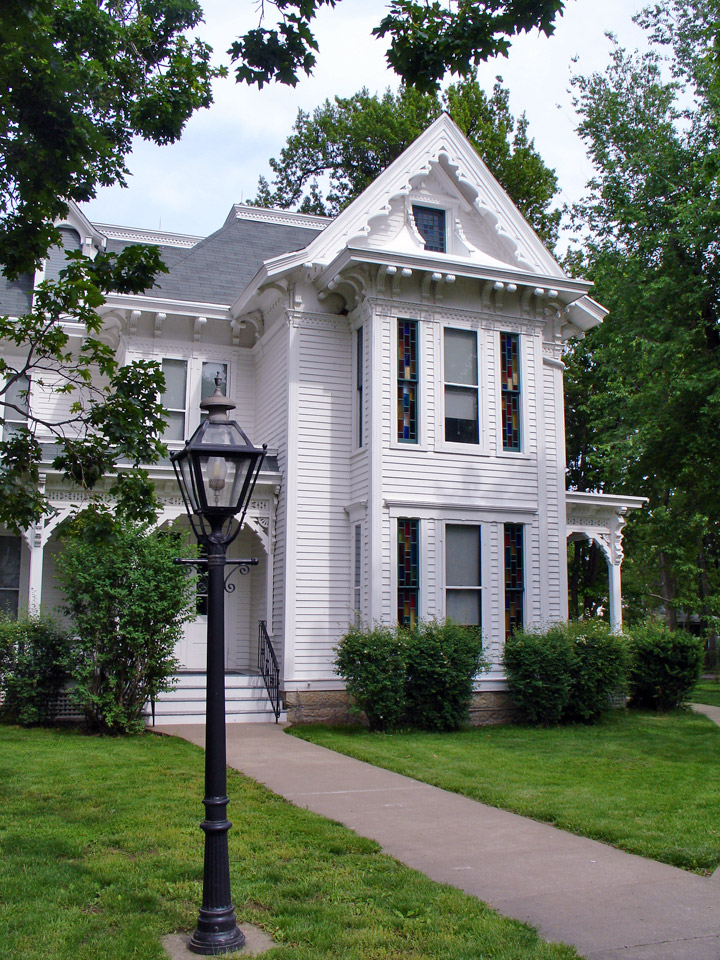
Truman Home
Harry S Truman (1884-1972), 33rd
President of the United States, lived here from 1919 until his death. The white
Victorian style house at 219 North Delaware Street was built by the maternal
grandfather of Bess Wallace Truman (1885-1982), and was known as the "Summer
White House" during the Truman administration (1945-1953). The site also
includes the two adjacent homes of Mrs. Truman's brothers, and, across Delaware
Street, the home of the President's favorite aunt and cousins.
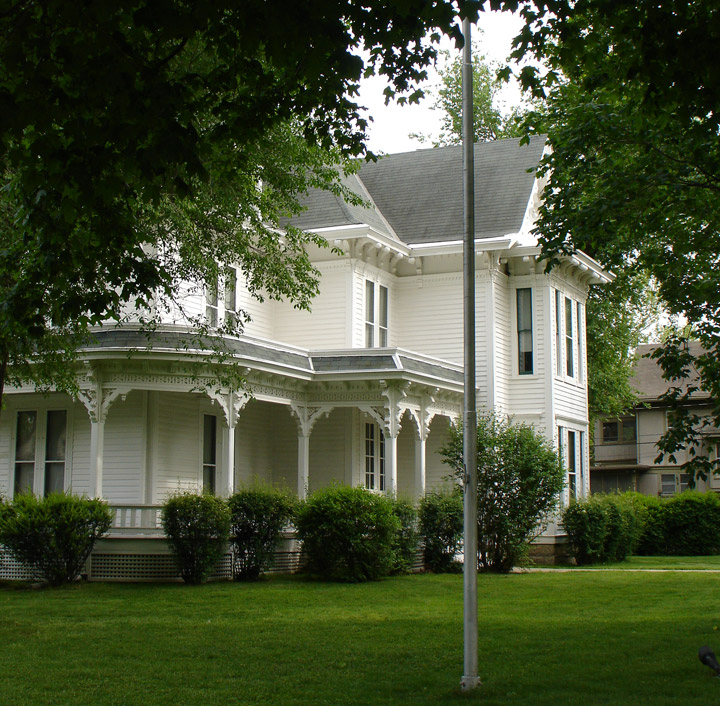
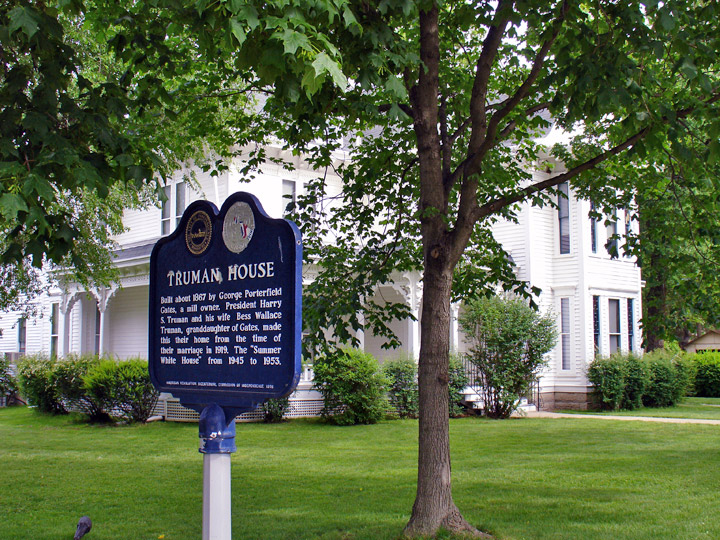

Harry S Truman Presidential Library
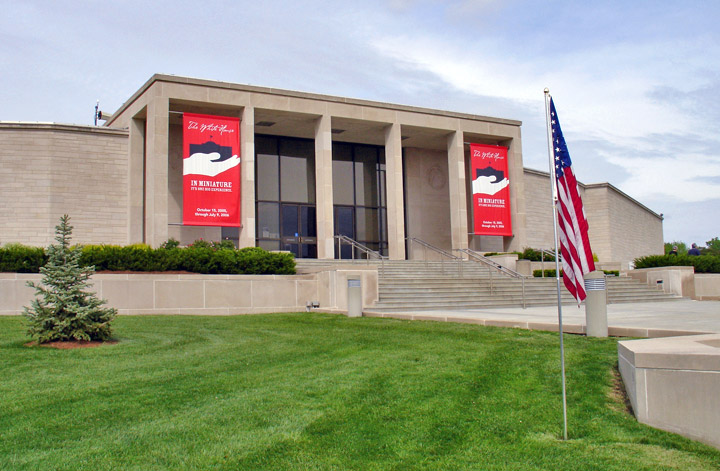
Truman, Harry S. (1884-1972), 33rd president of the United States (1945-1953). Truman initiated the foreign policy of containing Communism, a policy that was the hallmark of the Cold War. He continued the welfare policies established under his predecessor, President Franklin D. Roosevelt. Truman helped to centralize power in the executive branch, a trend begun under Roosevelt. Truman's willingness to accept responsibility for difficult decisions made him one of the most controversial of presidents. Throughout his administration, Truman failed to rally congressional support for most of his program of domestic legislation, called the Fair Deal. However, he did secure sufficient legislative backing to produce an outstanding record in foreign affairs, especially in meeting what most Americans felt was the challenge posed by the rising power of the Communist bloc. During Truman's administration the United States became a charter member of the United Nations (UN) and the North Atlantic Treaty Organization (NATO); sponsored important foreign policy initiatives known as the Truman Doctrine, the Marshall Plan, and Point Four Program; and assumed a leading role in the fighting in the Korean War (1950-1953).

Truman desk as President
formerly was in the Oval Office of the White House
Truman's ability to face situations squarely was well illustrated on November 1, 1950. Two Puerto Rican nationalists attempted to assassinate him at Blair House, his temporary residence during renovations at the White House. Truman's comment: "A president has to expect those things."

slogan on the President's desk
Harry S. Truman, the oldest of three children born to Martha Ellen Young Truman and John Anderson Truman, was born in his family's small frame house in Lamar, Missouri, in 1884. Truman had no middle name; his parents apparently gave him the middle initial S. to appease two family relatives whose names started with that letter.

being sworn in as President on the death of Roosevelt
When Truman was six years old, his family moved to Independence, Missouri, where
he attended the Presbyterian Church Sunday school. There he met five-year-old
Elizabeth Virginia ("Bess") Wallace, with whom he was later to fall in love.
Truman did not begin regular school until he was eight, and by then he was
wearing thick glasses to correct extreme nearsightedness. His poor eyesight did
not interfere with his two interests, music and reading. He got up each day at 5
AM to practice the piano, and until he was 15, he went to the local music
teacher twice a week. He read four or five histories or biographies a week and
acquired an exhaustive knowledge of great military battles and of the lives of
the world's greatest leaders.
In 1901, when Truman graduated from high school, his future was uncertain.
College had been ruled out by his family's financial situation, and appointment
to the U.S. Military Academy at West Point was eliminated by his poor eyesight.
He began work as a timekeeper for the Santa Fe Railroad at $35 per month, and in
his spare time he read histories and encyclopedias. He later moved to Kansas
City, where he worked as a mail clerk for the Kansas City Star, then as a clerk
for the National Bank of Commerce, and finally as a bookkeeper for the Union
National Bank. In 1906 he was called home to help his parents run the large farm
of Mrs. Truman's widowed mother in Grandview, Missouri.
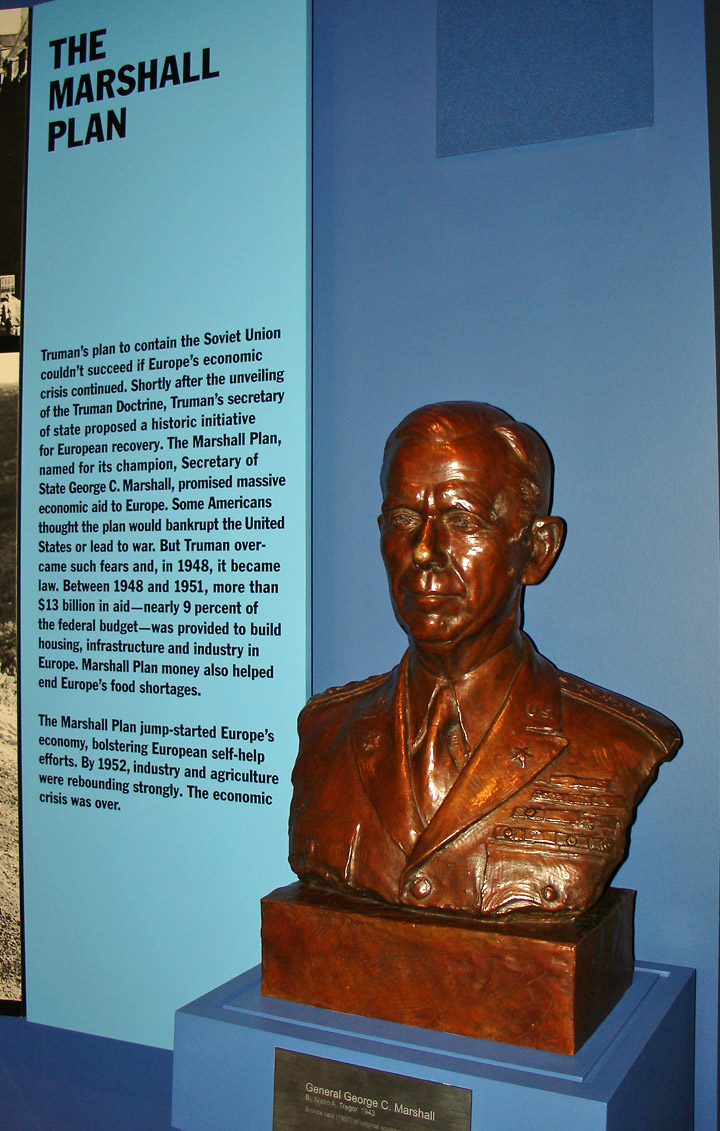
The Marshall Plan
For the next ten years, Truman was a successful farmer. He joined Mike Pendergast's Kansas City Tenth Ward Democratic Club, the local Democratic Party organization, and on his father's death in 1914 he succeeded him as road overseer. An argument soon ended the job, but Truman became the Grandview postmaster. In 1915 he invested in lead mines in Missouri, lost his money, and then turned to the oil fields of Oklahoma. Two years later, just before the United States entered World War I, he sold his share in the oil business and enlisted in the U.S. Army. He trained at Fort Sill, Oklahoma, but returned to Missouri to help recruit others. He was elected first lieutenant by the men of Missouri's Second Field Artillery.
AWorld War I World War I began in 1914 as a local European war between
Austria-Hungary and Serbia, when Archduke Francis Ferdinand, heir to the thrones
of Austria and Hungary, was assassinated by a Serbian nationalist. Though U.S.
President Woodrow Wilson tried to remain neutral, the United States was drawn
into the war in April 1917.
Truman sailed for France on March 30, 1918, and as a recently promoted captain
was given command of Battery D, a rowdy and unmanageable group known as the
Dizzy D. Truman succeeded in taming his unit, and the Dizzy D distinguished
itself in the battles of Saint-Mihiel and Argonne. In April 1919 Truman, then a
major, returned home, and on June 28 he married Bess Wallace.
The following November, Truman and Eddie Jacobson opened a men's clothing store
in Kansas City. With the Dizzy D veterans as customers the store did a booming
business, but in 1920, farm prices fell sharply and the business failed. In the
winter of 1922 the store finally closed, but Truman refused to declare
bankruptcy and eventually repaid his debts.

Model of the White House
Truman turned to the Pendergasts for help. Jim Pendergast, Mike's son, persuaded his father to give Truman permission to enter a four-way Democratic primary for an eastern Jackson County judgeship, which was actually a job to supervise county roads and buildings. Mike refused to support Truman. In addition, one of the other candidates was supported by the Ku Klux Klan, a semi-secret, often violent organization that championed white supremacy. Truman was advised to join the Klan, but when he objected to its discriminatory policies against blacks, Jews, and Roman Catholics, his entrance fee was returned. Nonetheless, by campaigning on his war record and Missouri background, Truman won the primary and the general election. In January 1923 he was sworn into his first public office. A year later the Trumans' only child, Mary Margaret, was born.
As one of three county judges, Truman had little authority to repair the bad
roads, the crumbling public buildings, or the depleted county treasury.
Nevertheless, he reduced his inherited debt of more than $1,000,000 by $600,000,
and he improved some of the roads. In his spare time he enrolled in the Kansas
City Law School, participated in the local Masonic Lodge, and maintained his
interest in the National Guard, eventually becoming a colonel.
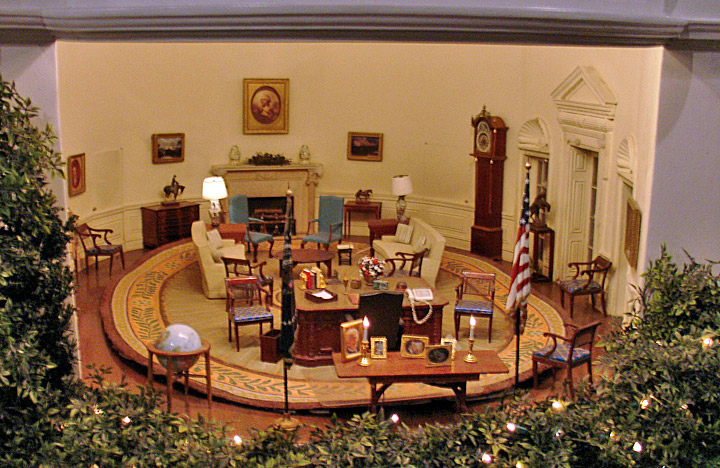
the Oval Office in the model of the White House
As his two-year term drew to a close, Truman stood for renomination in the Democratic primary. By this time, however, the party was badly split, and the Ku Klux Klan helped bring about his only election defeat. For the next two years he sold automobile club memberships and ventured into the banking business.
Political machines, such as the Pendergast organization, were common to both parties in the 1920s. They were based on the spoils system, in which winning politicians gave government jobs to those loyal party members who had helped them get elected. Using government jobs as rewards, politicians created efficient (and often almost unstoppable) vote-getting "machines," in which party loyalty was often more important than doing any work. Without local machine support a political career was extremely difficult. Political machines were especially powerful in Missouri. In 1926 Tom Pendergast, Mike's other son, supported Truman for a four-year term as presiding judge of the county with full authority over county roads, buildings, and taxes. Although the Pendergast machine was strong, with his characteristic bluntness, Truman told Pendergast he would fire any man who failed to do an honest job. Finding the road system a shambles, the courthouse in ruins, and tax money in the pockets of Pendergast supporters, Truman began wholesale firings. He appointed an independent road commission, hired reputable workers, secured out-of-state bank loans at low interest rates, and ended graft in building contracts. He toured the country to find the best-designed courthouse. He found it in Shreveport, Louisiana, hired its architect, and floated a successful bond issue to pay for a similar building in Kansas City. In 1929 Mike Pendergast died, and his two sons replaced him. Truman's influence was enhanced, and he was reelected to a second four-year term as presiding county judge.
By 1934 the Pendergast machine was the tool of gangsters who promoted gambling,
vice rings, bootlegging, police bribes, and murder. Truman, plodding along on
his honest road program and courthouse project, earned the respect of his
constituents, who may have been impressed by the novelty of an honest official.
However, a presiding judge was traditionally limited to two terms, and Truman
appeared to have no hope of a political future until Tom Pendergast asked Truman
to run for the U.S. Senate.
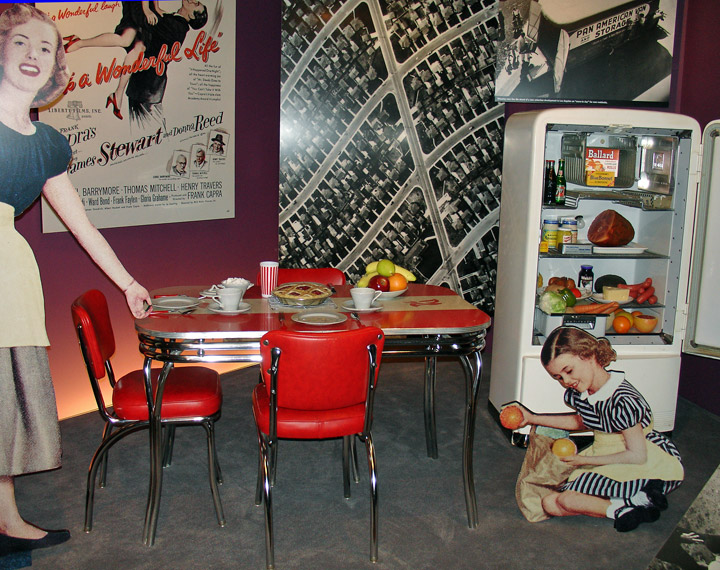
President during the late 40's and early 50's
After a long, hard battle, Truman soundly defeated his Republican opponent. Truman capitalized on the popularity of the New Deal, Democratic President Franklin D. Roosevelt's innovative domestic legislation to counteract the effects of the Great Depression. On January 3, 1935, Truman was sworn in as the junior senator from Missouri.
Truman's arrival in Washington was met with disdain. His colleagues regarded him
as a tool of the Pendergast machine, which the White House was already
investigating. Roosevelt believed that Truman would probably be implicated.
Fortunately, Truman's common sense and knowledge of government and history
impressed two of the Senate's most influential men. One was vice president John
Nance Garner, and the other was Arthur H. Vandenberg, Republican senator from
Michigan. With their aid, Truman was named to two important committees, the
Appropriations Committee and the Interstate Commerce Committee. Working on a
subcommittee of the latter with Senator Warren Austin, he wrote the
Truman-Austin bill that created the Civil Aeronautics Board.
Truman also joined the subcommittee on railroads, becoming vice-chairman and,
later, acting chairman. Steeping himself in the history of the industry, he
conducted hearings until early 1939. Despite pressures from powerful railroad
companies, including the Missouri Pacific Railroad, he recommended major
regulatory changes that were embodied in the Transportation Act of 1940.
Because he was a consistent New Deal
senator whom Roosevelt did not have to coerce and because the Pendergast
investigation was not completed, Truman was ignored by the White House. When the
investigation ended, it disclosed widespread corruption and brutality, but it
failed to reveal a single act of wrongdoing in Truman's career. In the light of
Roosevelt's hatred of Pendergast, Truman could have seriously damaged his career
when, learning of Pendergast's indictment, he told a reporter, "Tom Pendergast
has always been my friend, and I don't desert a sinking ship."
To no one's surprise, the two Missouri Democrats who brought about Pendergast's downfall challenged Truman for his Senate seat in the primary. One was Governor Lloyd Stark, whom Roosevelt supported, and the other was Maurice Milligan, whose nomination for a second term as U.S. district attorney Truman had opposed in the Senate. Truman began his primary fight with no political backing, no money, and two popular reformers as opponents. He traveled the state, making speeches about his record in short, simple language. He won the primary, and despite his Pendergast association, mentioned frequently by his Republican opponent, he won in November. His reelection was so unexpected that when he returned to the Senate, his colleagues gave him a standing ovation.

campaigning from the back of the train
In 1941 the United States government was preparing for World War II, a conflict that had begun in Europe in 1939. The government was building army camps and issuing defense contracts. Even before his second term began, Truman's constituents had written him about waste and confusion in the defense program. Truman toured the camps and defense plants and discovered appalling conditions. Back in the new Senate he denounced the defense program, demanded an investigation, and was named the head of the investigating committee.
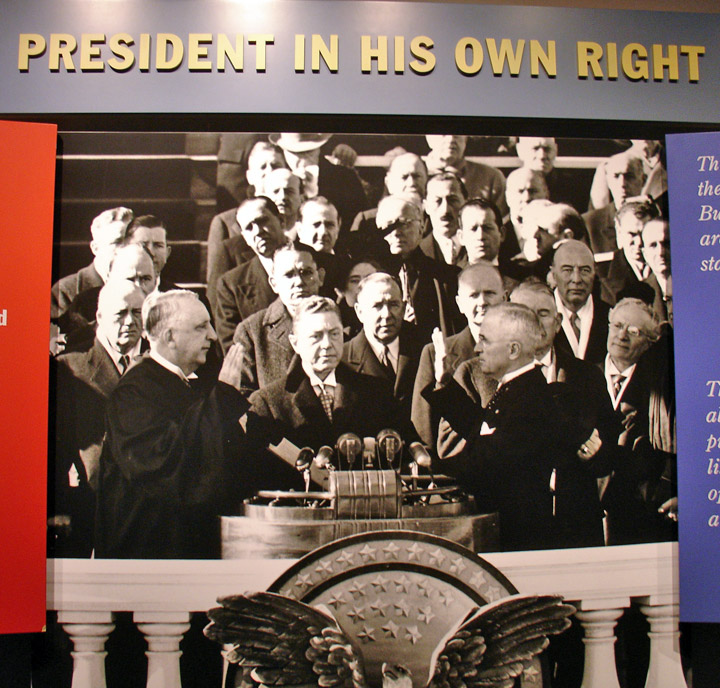
Inauguration for his full term
During the next two years the Truman committee produced detailed reports on the
defense programs. Committee members frequently visited defense installations to
substantiate the testimony of contractors, engineers, and army and government
personnel. Truman's success in uncovering fraud and waste led the Senate in 1942
to give the committee $100,000, an increase of $85,000 over the first year. It
was estimated that the Truman committee saved the country $15 billion and spent
only $400,000.
The committee also put Truman on the national stage. With increasing frequency,
leading Democrats mentioned Harry S. Truman as a potential 1944
vice-presidential candidate.

Before the Democratic National Convention opened in July 1944, it was assumed
that Roosevelt would run for a fourth term, but his health became a matter of
great concern to party leaders, whose most difficult task was to name his
running mate. The current vice president was Henry A. Wallace, a strong
proponent of using the federal government to regulate big businesses, protect
the civil rights of minorities, and encourage labor unions. Wallace's liberal
views offended many of the more conservative leaders of the Democratic Party,
and they encouraged Roosevelt to find someone more appealing to mainstream
voters. Among the leading contenders were Supreme Court Justice William O.
Douglas, and Senators Alben W. Barkley, James F. Byrnes, and Truman. Truman was
nominated on the second ballot. After a whirlwind campaign and overwhelming
victory, Truman took the oath of office as vice president on January 20, 1945.
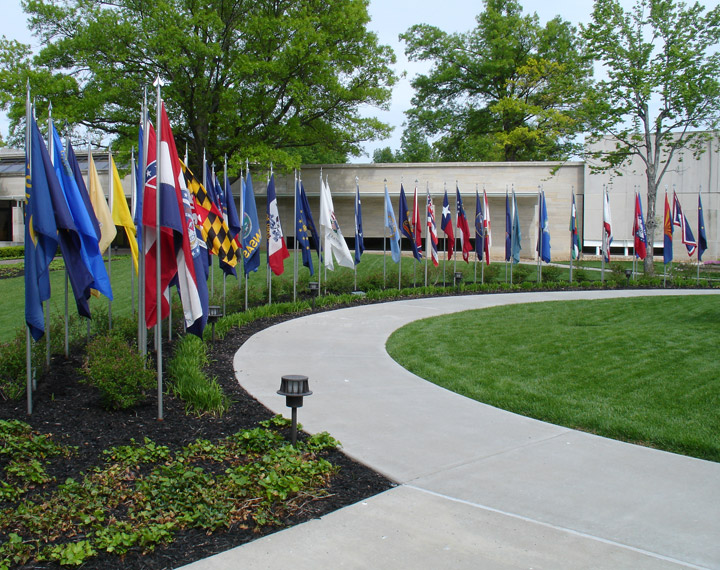
Truman then engineered the Senate confirmation of Roosevelt's appointment of
Henry Wallace as secretary of commerce and Federal loan administrator, attended
the funeral of Tom Pendergast despite wide criticism, and cast the tie-breaking
Senate vote that ensured that the United States would continue delivering
supplies to U.S. allies after the war was over. However, he saw very little of
the president. Soon after the inauguration, Roosevelt left Washington for the
month-long Yalta Conference, where the Allies discussed military strategy and
political problems, including plans for governing Germany after the war.
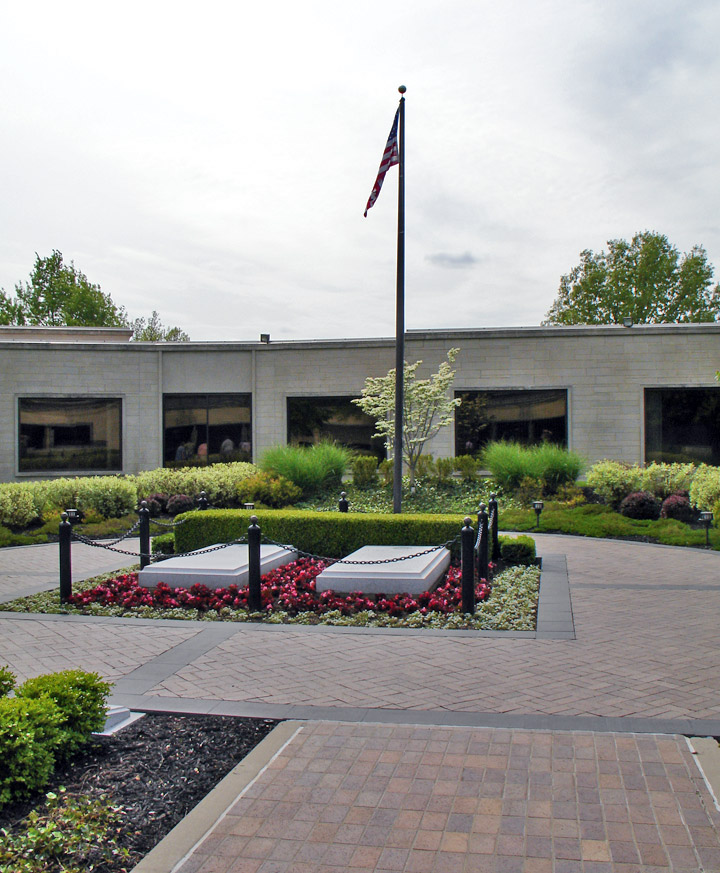
When Roosevelt returned in March, he met with Truman in two short meetings. When
Roosevelt left for Warm Springs, Georgia, on March 30, Roosevelt had still not
informed his vice president about the conduct of the war or the plans for peace.
Thirteen days later, Truman was summoned to the White House, where Eleanor
Roosevelt told him, "Harry, the president is dead."
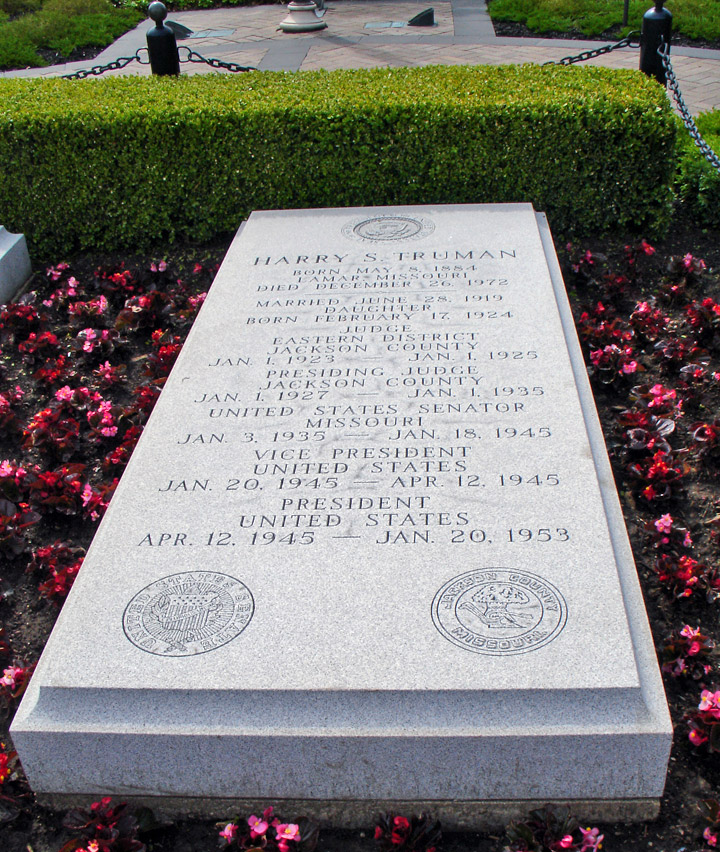
grave site of Harry S. Truman
At 7:09 PM on April 12, 1945, Harry
S. Truman, who had been vice president of the United States for just 82 days,
was sworn in as president by Chief Justice Harlan F. Stone. Truman's first month
in office was largely devoted to briefings by Roosevelt's aides. He asked the
founding conference of the United Nations to meet in San Francisco on April 25,
as had been planned before Roosevelt's death. When victory in Europe seemed
certain, he insisted on unconditional German surrender, and on May 8, 1945, his
61st birthday, he proclaimed Victory-In-Europe Day (V-E Day).
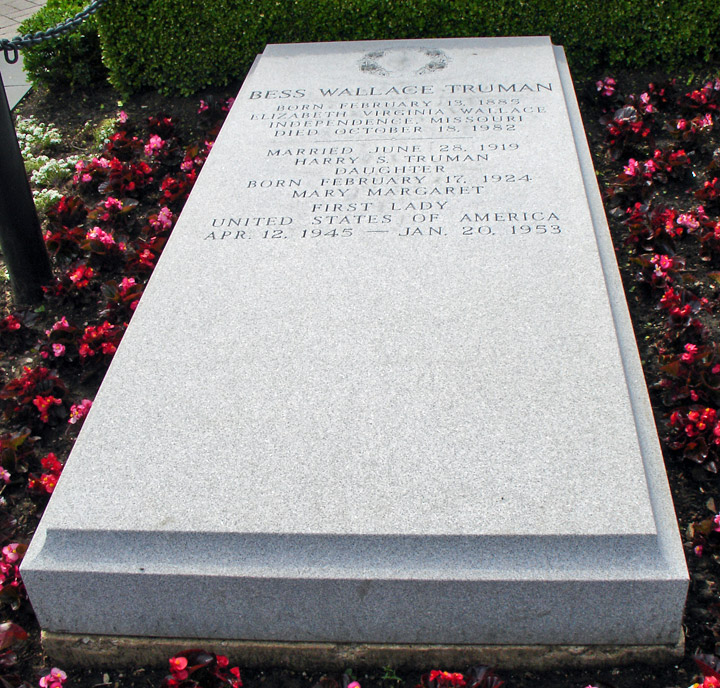
grave site of Bess Wallace Truman
Truman convinced the San Francisco conference delegation of the Union of Soviet Socialist Republics (USSR) that the general assembly of the new world peace organization should have free discussions and should make recommendations to the security council. On June 26 he addressed the final conference session, and six days later he presented the United Nations Charter to the Senate for ratification.
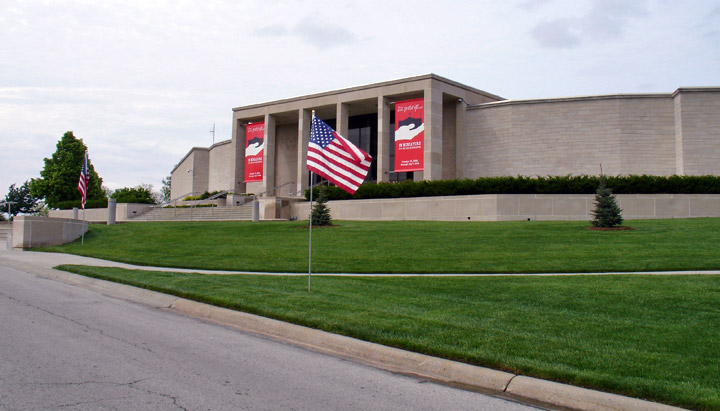
From July 17 to August 2, 1945, Truman attended the Potsdam Conference in
Germany, meeting with Soviet Premier Joseph Stalin, British Prime Minister
Winston Churchill, and Clement Attlee, Churchill's successor as British prime
minister. The conference discussed how to implement the decisions reached at the
Yalta Conference. As presiding officer, Truman proposed the establishment of the
council of foreign ministers to aid in peace negotiations, settlement of
reparations claims, and conduct of war crimes trials. He also gained Stalin's
promise to enter the war against Japan. In this first meeting with the other
Allied leaders, Truman confirmed his earlier favorable impression of Churchill,
while he called the Soviets, in one of his typically blunt statements,
"pigheaded people."
On July 26, Truman issued the Potsdam Declaration, which called for Japan's
unconditional surrender and listed peace terms. He had already been informed of
the successful detonation of the first atomic bomb at Alamogordo, New Mexico,
ten days earlier. Military advisers had told Truman that a potential loss of
about 500,000 American soldiers could be avoided if the bomb were used against
Japan. When Japan rejected the ultimatum, Truman authorized use of the bomb. On
August 6, 1945, at 9:15 AM Tokyo time, the bomb was dropped on Hiroshima,
virtually destroying the city. According to U.S. estimates about 60,000 to
70,000 people were killed or missing as a result of the bomb and many more were
made homeless. Stalin sent troops into Manchuria and Korea on August 8, and the
following day a second bomb was dropped on Nagasaki. About one-third of the city
was destroyed, and according to U.S. estimates about 40,000 people were killed
or injured. Japan sued for peace on August 14. The official Japanese surrender
took place on September 2, 1945, aboard the U.S.S. Missouri anchored in Tokyo
Bay.
Text from Microsoft Encarta